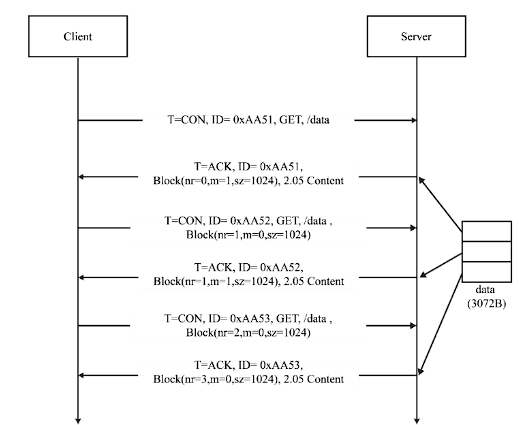Congestion Control in CoAP Protocol: A Case study of Observing Resource with Block-Wise Transfer
doi: 10.14456/mijet.2023.11
Keywords:
Block-Wise Transfer, CoAP, Congestion Control, Group Communication, IoT, Observe ResourceAbstract
The Constraint Application Protocol (CoAP) is a restricted protocol used for communication in the Internet of Things (IoT). It allows limited resource devices to connect to the Internet, exchange request/response messages, and block-wise transfer for large data transfers. CoAP also includes an observed mode, which allows a client to monitor resources on servers and receive notification messages via unicast when the state of the resource is changed. However, the default congestion control algorithm used by CoAP, called Binary Exponential Back-Off (BEB), is insufficient for group communication resource observation with block-wise transfer and can lead to significant congestion, resulting in a buffer overflow, data loss, and connection drop. To address this problem, we conducted a study to evaluate the effectiveness of two alternative algorithms for congestion control in CoAP: Fibonacci Pre-Increase Back-off (FPB) and Half Binary Exponential Backoff (HBEB) algorithms. We tested these algorithms using a Cooja simulation and compared their performance to the default BEB algorithm. Our results showed that HBEB outperformed both BEB and FPB in terms of throughput and packet loss ratio (PLR), where BEB provides the best in term of end-to-end delay.
References
P. Sharma, I. Pandey, and P. M. Pradhan, "Hardware Implementation and Comparison of IoT Data Protocol for Home Automation Application," in 2022 IEEE Delhi Section Conference (DELCON), pp.1–6, 2022 doi: 10.1109/DELCON54057.2022.9752957.
D. Ray, P. Bhale, S. Biswas, S. Nandi, and P. Mitra, "DAISS: Design of an Attacker Identification Scheme in CoAP Request/Response Spoofing," in TENCON 2021-2021 IEEE Region 10 Conference (TENCON), pp. 941–946, 2021, doi: 10.1109/TENCON54134.2021.9707405.
D. Ugrenovic and G. Gardasevic, "CoAP protocol for Web-based monitoring in IoT healthcare applications," Nov. 2015. doi: 10.1109/TELFOR.2015.7377418.
M. D. Babakerkhell and N. Pandey, "Analysis of different IOT based healthcare monitoring systems," Int J Innov Technol Explor Eng (IJITEE), 2019.
P. K. Rath, N. Mahapatro, S. Sahoo, and S. Chinara, "IoT Based Health Monitoring System for Hospital Management," 2021.
A. Aldribi and A. Singh, "Blockchain Empowered Smart Home: A Scalable Architecture for Sustainable Smart Cities," Mathematics, vol. 10, no. 14, p. 2378, 2022.
S. Beloualid, S. El Aidi, A. El Allali, A. Bajit, and A. Tamtaoui, "Applying Advanced IoT Network Topologies to Enhance Intelligent City Transportation Cost Based on a Constrained and Secured Applicative IoT CoAP Protocol," Advances in Information, Communication and Cybersecurity: Proceedings of ICI2C’21, vol. 357, p. 195, 2022.
E. Ancillotti and R. Bruno, "Comparison of CoAP and CoCoA+ congestion control mechanisms for different IoT application scenarios," in 2017 IEEE Symposium on Computers and Communications (ISCC), pp. 1186–1192, 2017, doi: 10.1109/ISCC.2017.8024686.
J. Youn and H. Choi, "CoAP-based Reliable Message Transmission Scheme in IoT Environments," Journal of the Korea Society of Computer and Information, vol. 21, pp. 79–84, 2016, doi: 10.9708/jksci.2016.21.1.079.
A. Betzler, C. Gomez, I. Demirkol, and J. Paradells, "CoCoA+: An advanced congestion control mechanism for CoAP," Ad Hoc Networks, pp. 126–139, 2016, doi: 10.1016/j.adhoc.2015.04.007.
R. Bhalerao, S. S. Subramanian, and J. Pasquale, "An analysis and improvement of congestion control in the CoAP Internet-of-Things protocol," in 2016 13th IEEE Annual Consumer Communications & Networking Conference (CCNC), pp. 889–894, 2016. doi: 10.1109/CCNC.2016.7444906.
C. Bormann, A. Betzler, C. Gomez, and I. Demirkol, "CoAP Simple Congestion Control/Advanced," Internet Engineering Task Force, Internet Draft draft-ietf-core-cocoa-00, 2017. [Accessed: Jan. 28, 2022].
H. Meng, H. HongBing, and L. WeiPing, "An Adaptive Congestion Control Algorithm with CoAP for the Internet of Thing," Int. J. Comput. Tech, vol. 4, pp. 46–51, 2017.
I. Jarvinen, I. Raitahila, Z. Cao, and M. Kojo, "FASOR Retransmission Timeout and Congestion Control Mechanism for CoAP," in 2018 IEEE Global Communications Conference (GLOBECOM), pp. 1–7, 2018, doi: 10.1109/GLOCOM.2018.8647909.
S. Bolettieri, G. Tanganelli, C. Vallati, and E. Mingozzi, "pCoCoA: A precise congestion control algorithm for CoAP," Ad Hoc Networks, vol. 80, pp. 116–129, 2018, doi: 10.1016/j.adhoc.2018.06.015.
V. Rathod, N. Jeppu, S. Sastry, S. Singala, and M. P. Tahiliani, "CoCoA++: Delay gradient based congestion control for Internet of Things," Future Generation Computer Systems, vol. 100, pp. 1053–1072, 2019, doi: 10.1016/j.future.2019.04.054.
G. A. Akpakwu, G. P. Hancke, and A. M. Abu-Mahfouz, "CACC: Context-aware congestion control approach for lightweight CoAP/UDP-based Internet of Things traffic," Transactions on Emerging Telecommunications Technologies, vol. 31, no. 2, p. e3822, 2020.
R. K. Yadav, N. Singh, and P. Piyush, "Genetic CoCoA++: genetic algorithm based congestion control in CoAP," in 2020 4th International Conference on Intelligent Computing and Control Systems (ICICCS), pp.808–813, 2020. doi: 10.1109/ICICCS48265.2020.9121093.
M. A. Tariq, M. Khan, M. T. Raza Khan, and D. Kim, "Enhancements and Challenges in CoAP—A Survey," Sensors, vol. 20, no. 21, 2020, doi: 10.3390/s20216391.
I. Järvinen, L. Daniel, and M. Kojo, "Experimental evaluation of alternative congestion control algorithms for Constrained Application Protocol (CoAP)," in 2015 IEEE 2nd World Forum on Internet of Things (WF-IoT), pp. 453–458, 2015, doi: 10.1109/WF-IoT.2015.7389097.
C. Suwannapong and C. Khunboa, "EnCoCo-RED: Enhanced congestion control mechanism for CoAP observe group communication," Ad Hoc Networks, vol. 112, p. 102377, 2021, doi: 10.1016/j.adhoc.2020.102377.
I. Essop, J. C. Ribeiro, M. Papaioannou, G. Zachos, G. Mantas, and J. Rodriguez, "Generating Datasets for Anomaly-Based Intrusion Detection Systems in IoT and Industrial IoT Networks," Sensors, vol. 21, no. 4, 2021, doi: 10.3390/s21041528.
V. J. Rathod and M. P. Tahiliani, "Geometric Sequence Technique for Effective RTO Estimation in CoAP," in 2020 IEEE International Conference on Advanced Networks and Telecommunications Systems (ANTS), pp. 1–6, 2020. doi: 10.1109/ANTS50601.2020.9342748.
N. Makarem, W. Bou Diab, I. Mougharbel, and N. Malouch, "On the design of efficient congestion control for the Constrained Application Protocol in IoT," Computer Networks, vol. 207, p. 108824, 2022, doi: 10.1016/j.comnet.2022.108824.
S. Deshmukh and V. T. Raisinghani, "AdCoCoA- Adaptive Congestion Control Algorithm for CoAP," in 2020 11th International Conference on Computing, Communication and Networking Technologies (ICCCNT), pp. 1–7, 2020, doi: 10.1109/ICCCNT49239.2020.9225315.

Downloads
Published
How to Cite
Issue
Section
License

This work is licensed under a Creative Commons Attribution-NonCommercial-NoDerivatives 4.0 International License.








